FRIDAY
MARCH 15 - 2019
Brook
Meadow
I went over to
the meadow this morning to carry out the annual count
of Butterbur flower spikes. I started with the
main area of Butterbur growth immediately below the
seat. Using the nearby cut Willow twigs to mark out
the sections for counting, I counted 352 flower spikes
in this area. Next, I counted the other areas as
follows: river bank 26, the south meadow 16 and the
east end of the causeway 21 making a grand total of
415.

As today's count is
about 200 lower than counts in the past few years, I
shall endeavour to carry out another one in a week's
time, just in case the low number is due to a slightly
earlier than usual count. The following chart shows
the Butterbur counts each year.
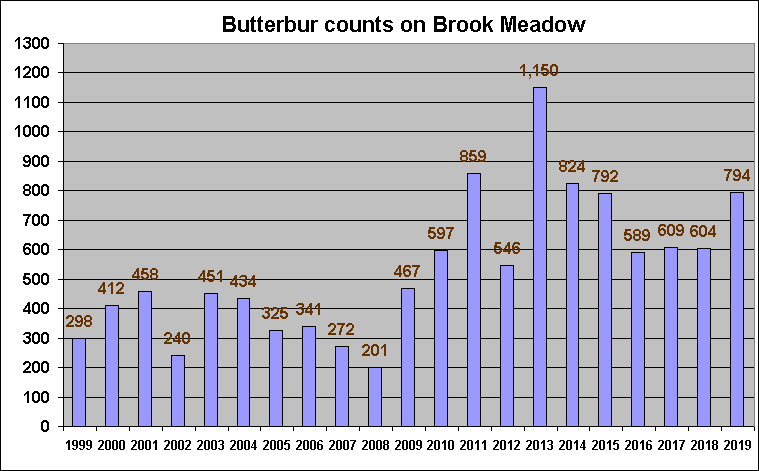
The first brown spikes
of the Lesser Pond Sedge on the river bank
south of the S-bend are now visible. These are always
the first of the sedges to emerge in early spring, but
Mar 15 is the earliest date I have ever recorded the
spikes - a sign of climate change.

As I was carrying out
the Butterbur count I heard two bursts from a
Cetti's Warbler, both from the south meadow. As
this is our 3rd hearing of the Cetti's Warbler song on
Brook Meadow - sign of possible breeding?
It was interesting to
see that the flood warning sign has been torn
from the posts at the north end of the south meadow. I
can empathise with whoever who did this as the notice
which was erected by the Environment Agency without
consulting the Brook Meadow Conservation Group is
quite superfluous and detracts from the attractiveness
of the meadow. The other flood warning notice at the
southern end of the meadow near the south gate has not
been touched. Although the south east corner of the
meadow is currently flooded, the notice does nothing
more than draw a visitor's attention to the obvious.
Langstone
Mill Pond
Despite the
gloomy weather and light drizzle, Peter Milinets-Raby
quickly visited Langstone Mill Pond this morning (9am
to 10:25am - low tide). His report follows . . .
I found the five Cattle Egrets perched on the trees at
the back of the pond with 5 Little Egrets. Dare I say
it, they looked very contented. One bird (see photo)
is clearly in the middle of moulting out its crest.
This bird has been like this for nearly two weeks.
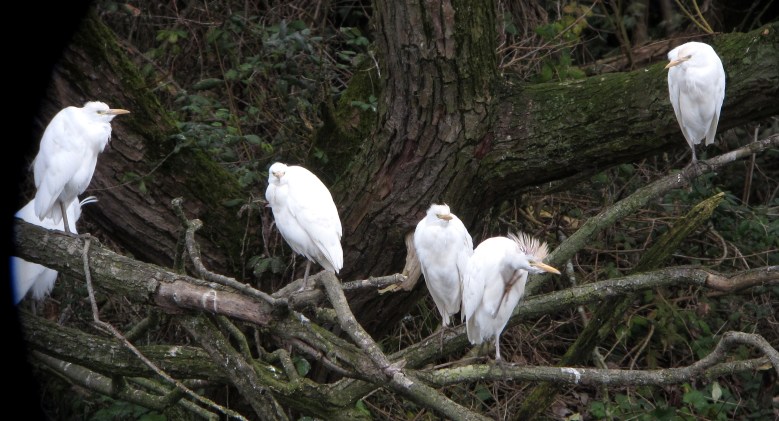
Other birds of note on
the pond were 2 singing Chiffchaff, 3 Teal and a
resting Cormorant. The top nest in the Holm Oak had 4
young in it, not three as posted a week ago.
Off shore were 25 Black-tailed Godwits, 7 Pintail, 7
Common Gulls, 92 Brent Geese, 6 Teal, 28 Shelduck, 5
Red Breasted Mergansers, 3 Great Crested Grebes and 11
Med Gulls.
In the paddock were 4 Little Egret, 3 Grey Herons, 17
Wigeon, 55 Teal and a Green Woodpecker.
Note about Cattle
Egrets:
Peter tells me that this will be the last time he
reports on the Cattle Egrets, just in case they do
breed. This will be a first for Langstone Mill Pond.
He will keep me informed, but in accordance with
ornithological policy regarding the reporting of rare
breeding species, I shall not include any further news
about the Cattle Egrets on this blog.
WEDNESDAY
MARCH 13 - 2019
Warblington
Despite the
wind, Peter Milinets-Raby had a wander around
Warblington this morning 9am to 12:25pm - low
tide.
The field to the west of the cemetery held 5 Cattle
Egrets and 29 Little Egrets with 120+ Black-headed
Gulls and 7 Mediterranean Gulls. The Little Egrets
were constantly interacting with each other quite
frequently, stretching their necks, fluffing up their
moulting plumes and leaping in the air. Sorting out
early pair bonding and pecking orders.
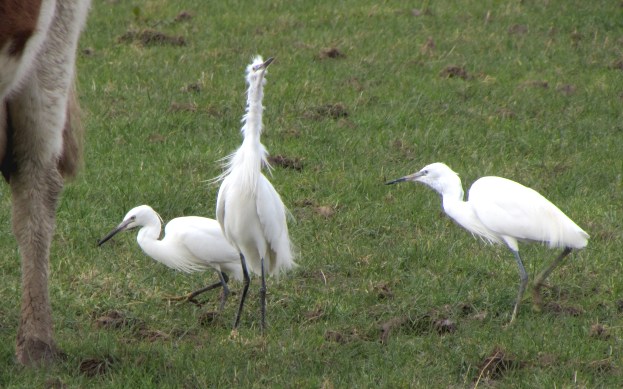
Hopefully this amorous
behaviour will get into the psyche of the ever
lingering Cattle Egrets.
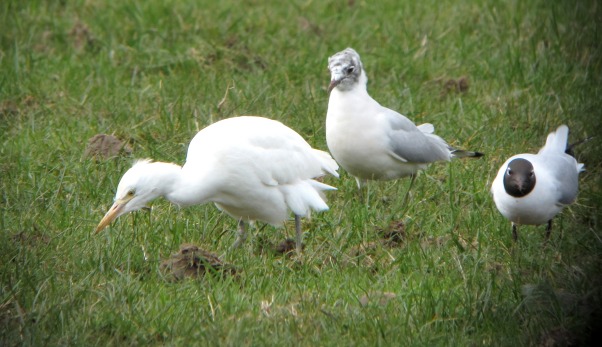
Hay dump: I bumped
into fellow birder Mark Wagstaff and had a pleasant
short chat while we watched 4+ Meadow Pipits on the
hay dump and had nice views of a Peregrine that dashed
low over the stubble fields on the lookout for
pigeons.
After loitering for over an hour, I managed to see 2
Water Pipits, 1 Rock Pipit, 1 Grey Wagtail and only 2
Pied Wagtails. Singing from the cress beds were a
Chiffchaff and a Cetti's Warbler. Too windy for
photos, so didn't get anything in focus.
On the old hay dump muddy square were 7 Meadow Pipits,
4 Pied Wagtails, a Song Thrush and another Water
Pipit.
On the tidal shore off Pook Lane (very windy) were 155
Black-tailed Godwits, 35 Shelduck, a single Great
crested Grebe, 5 Red Breasted Mergansers and on the
shore of the muddy island in the middle of the channel
was a very lost looking male Pheasant!!
Daffodils
on Brook Meadow
We are
grateful to local photographer John Tweddle for
sending us this lovely image that he got recently of
Daffodils in flower on the river bank on Brook Meadow.
This is a view looking south down river from the path
near the main seat.

MONDAY
MARCH 11 - 2019
Emsworth
walk
I had breezy
morning stroll through Brook Meadow and down to
Slipper Millpond looking out for signs of spring. The
first flush of green is now showing well on the large
Weeping Willow tree at the north end of the
south meadow. What a fine tree.

Also, on Brook Meadow
the yellow catkins are opening on the Osiers on
the east side of the north meadow.

The Goat Willow at the
northern end of Bridge Road car park has been loaded
with pussy willow catkins for over a week.
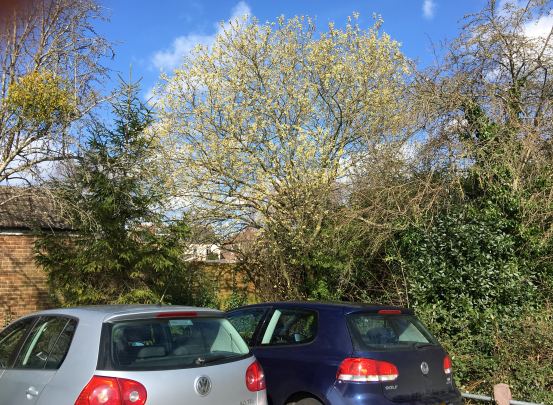
Another good sign of
spring was the first Hawthorn leaves which are
just emerging on the path behind Lillywhite's Garage;
leaves come before flowers on Hawthorn, unlike
Blackthorn where the flowers come first.
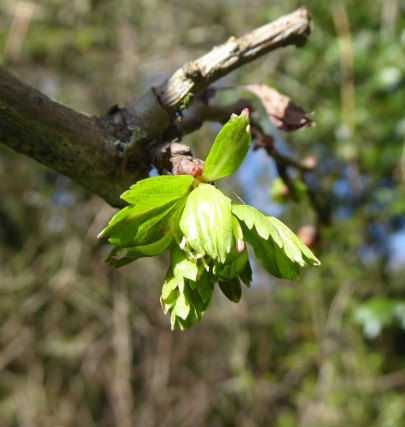
Down on Slipper
Millpond I found the pair of Great Black-backed
Gulls ensconced on the centre raft in company with
a Cormorant. The signs are very good, but I do not
expect them to be nest building until the end of this
month. I wonder if the Canada Geese will turn up this
year?

Warblington
Despite the
strong winds, Peter Milinets-Raby was out this morning
to wander around Warblington 9am to 10:14am - low tide
throughout. Here is the report . . .
A small tree had been
blown down by the cemetery blocking the main path to
Emsworth (see photo). A bit awkward to get around, but
I managed it.

In the field to the
east of the cemetery were the usual 5 Cattle
Egrets and 24 Little Egrets. All the Little Egrets
are fast acquiring their summer plumes and are only 3
weeks away from returning to Langstone Mill pond to
breed. In previous years the Cattle Egrets had left by
mid February, so as each day passes and these birds
linger, it gets more exciting that they birds may stay
to breed and hopefully attach themselves to the Little
Egret flock and join them!! So exciting! Having stated
that they will probably all fly off tomorrow! Also in
the field were 9 Med Gulls.
Other birds of note were as follows. Ibis field held
two Grey Wagtails - a pair with the male singing
frequently.
Hay dump: 4+ Meadow Pipit, 2 Rock Pipit, 2 Water
Pipit, 7 Pied Wagtail and a singing, Chiffchaff.
Conigar Point : 5 Shelduck, 28 Brent Geese, 1
Greenshank, 2 Grey Plover,
Off Pook Lane : 24 Shelduck, 5 Red Breasted Merganser,
8 Pintail, 36 Teal, 135 Black tailed Godwit, 3 Bar
tailed Godwit, 1 Great Crested Grebe.
FRIDAY
MARCH 8 - 2019
Nore
Barn
I got to Nore
Barn at about 09.50 with the tide already rising fast.
The Spotted Redshank was in the stream as usual
and remained throughout my visit. There was no sign of
its regular feeding companion the colour-ringed
Greenshank (G+GL).

I was interested to
see two Mediterranean Gulls in amongst the
Black-headed Gulls - Med Gulls are relatively unusual
at this site. The Med Gulls have jet black heads and
are preening the centre of the photo.
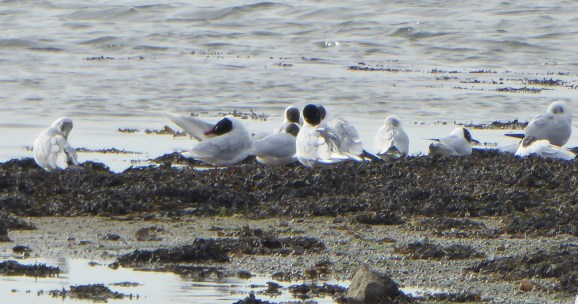
There were still
plenty of Brent Geese, Wigeon and Teal, but numbers
are now falling as birds move off towards their
breeding grounds further north, much further in the
case of the Brents! I counted 13 Black-tailed
Godwits near the stream though there were a few
more up the creek where I took this photo of some of
them wading in the shallow water.

Peter Milinets-Raby
turned up to do his regular count of the birds in the
harbour - see below for Peter's much more detailed
report of the birds in the area. While we were
chatting a lady approached us with the news that she
had just seen a Goldcrest in the woods. We discussed
the possibility of Firecrest, but she confirmed she
saw no sign of the tell-tale white on its head.
Wayside
flowers
On my way to
Nore Barn I stopped to have a look at an excellent
display of Sweet Violets on the grass verge on the
north side of Warblington Road by the junction with
Valetta Park which Nicola Hammond alerted me to.
Nicola sent me a selection of her very colourful
photos of the verge showing the Sweet Violets mixed in
with a variety of other common wayside flowers. Other
wild flowers I noted in the immediate vicinity were
Red Dead-nettle, Groundsel, Common Field Speedwell,
Common Chickweed, Shepherd's Purse, Daisy, Common
Mouse-ear and Hairy Bittercress.
Here is one of
Nicola's photos showing Sweet Violets with Red
Dead-nettle.

Emsworth
to Langstone
Peter
Milinets-Raby went from Emsworth Harbour to Langstone
Mill Pond this morning (9:11am to 11:33am with tide
coming in fast to high tide. Here is his detailed
report . . .
Beacon Square:
74 Brent Geese, 36 Wigeon, 2 Grey Plover, 2 Teal, 4
Black-tailed Godwits, Female Red Breasted Merganser, A
pair of Pintail, 1 Dunlin,1 Redshank with colour rings
-//G + G//YG - Seen 5+ times since 2016.
Emsworth Harbour: 173 Brent Geese, 1 Great
Black-backed Gull, 2 male Gadwall, 9 Med Gulls, 5
Turnstone, 21 Mute Swan, 14 Coot (7 on the Mill Pond
with 2 Mute Swans), 14 Shelduck, 2 Little Grebe, 2
Grey Plover.
Nore Barn: 1 Spotted Redshank, 67 Wigeon, 9
male & 7 female Pintail, 24 Teal, 14 Black-tailed
Godwits, 133 Brent Geese, 2 Med Gulls with several
calling and flying overhead. 3 Shelduck, 2 Grey
Plover, 2 Buzzard mid channel.
Langstone Mill
Pond: Chiffchaff heard singing, 2 Stock Dove, Reed
Bunting heard singing, 11 Teal, 1 Kestrel.
Grey Heron Nest 10: Adult bringing sticks to old nest
site to rebuild. This nest was blown away by the
storms.
Off shore on the last piece of salt marsh
before the tide finally pushed in: 181 Black-tailed
Godwits - all of which transferred to the paddock (see
later), 5 Common Gulls, 15 Med Gulls swimming on water
and 35 feeding in one of the Pook Lane fields, 153
Brent Geese, 2 Shelduck, 25 Wigeon, 2 Teal, 39 Curlew
on the last bit of salt marsh before flying off to the
Oyster-beds.
Flooded Horse paddock: 198 Black-tailed Godwit
- all roosting and preening so very difficult to get
colour ring details. Three definites from the other
day R//R + GR//- and W//R + YN//- and B//R + GB//-. 60
Teal, 14 Wigeon, 5 Grey Herons collecting sticks, 3
Little Egrets.
THURSDAY
MARCH 7 - 2019
Nore
Barn
Yesterday (Mar
6) Peter Milinets-Raby wandered around Nore Barn
(9:05am to 9:45am - tide pushing in quickly to high
tide) before meeting up with John Norton. It was good
to hear that the Spotted Redshank was present
and looking in good health.

As Peter says, there
is not many weeks left for this bird before it departs
to the north somewhere. On the basis of past
experience I would expect the Spotted Redshank to be
leaving in the 3rd week in March. See the special
dedicated web page for the history of this remarkable
bird. . . . Spotted
Redshanks at Nore Barn
Also present at Nore
Barn were the regular colour-ringed Greenshank (G+GL),
1 Black-tailed Godwit, 92 Wigeon, 14 Pintail (all
paired up - 7 pairs - a good count for March), 7
Shelduck, 2 Med Gulls, 244 Brent Geese, 2 Canada
Geese, And in Nore Barn Wood 1 Coal Tit and 1 Great
Spotted Woodpecker.
Warblington (10am). 27
Little Egrets and 5 Cattle Egrets in the usual field.
2 Green Woodpeckers in the cemetery.
Hay dump: 6+ Pied Wagtails, 3+ Meadow Pipit, 3+ Water
Pipits, 1 Chiffchaff. 1 Linnet, Skylark heard singing.
16 Brent Geese on the field.
Loads of flowers
noted - Field Madder, Field Pansy to name but two (see
photo of Field Pansy).

Slipper Mill Pond
(Noon): 2 Great Black-backed Gulls with a pair of Red
Breasted Mergansers.
Peter Pond: 2 full summer plumaged Little Grebes
diving constantly - very unusual record - Let's hope
they stay.
News
from Cuba
Malcolm
Phillips sends his good wishes to all from his new
home in Cuba along with a couple of photos to share .
. .
A pair of Caracaras and a Black-Billed Cuckoo.
TUESDAY
MARCH 5 - 2019
Langstone
Mill Pond
Peter
Milinets-Raby spent a delightful couple of hours down
by Langstone Mill Pond this morning (9am to 11:11am -
high tide mostly).
The highlight of the morning was the flooded horse
paddock just north of the pond which was brimming with
birds. The paddock held 23 Wigeon, 78 Teal, up to 4
Grey Herons collecting sticks for their nests, 4
Moorhen, a single Little Egret, 12 Mallard, a single
Oystercatcher
A very an impressive
flock of 166 Black-tailed Godwits which contained six
colour ringed individuals - totally unprecedented
numbers present. Over the last six years the most I've
ever had on this paddock were only ever 15 to 20 or
so.
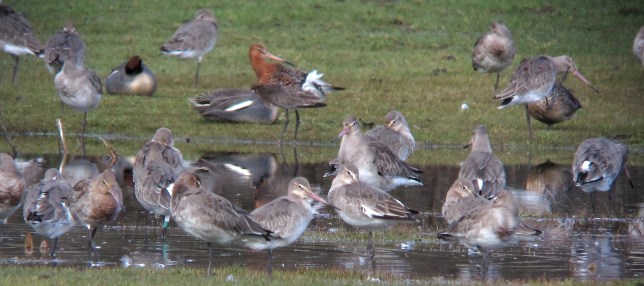
Colour ringed
Black-tailed Godwits
B//R + WR//- Seen
twice since 2014
R//R + GR//- Recorded
in the area since March 2011 - Under 10 sightings.
Ringed
05-Sep-10 Farlington Marshes LNR, Farlington RG - Pete
Potts
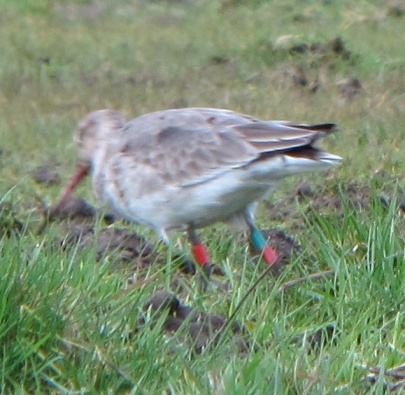
G//R + BG//- Tricky
combination to observe and actually had me questioning
my own vision, especially when seen alongside the bird
below!!! Five sightings since 2014.
A
regular in Emsworth Harbour since 2010.
B//R + GB//- Not seen
before - Not surprised really as this colour
combination was a bugger to see correctly. Wonderful
to have both birds in the same flock!
Ringed
15-Oct-13 Farlington Marshes
B//R + LG//- One
previous sighting in April 2018
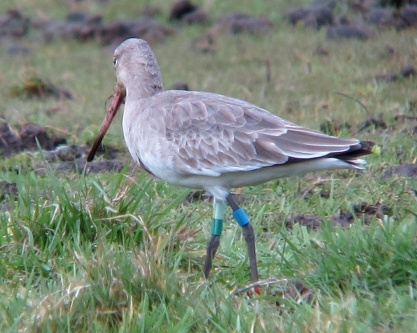
W//R + YN//- Recorded
in the area since March 2011 - Under 5
sightings.
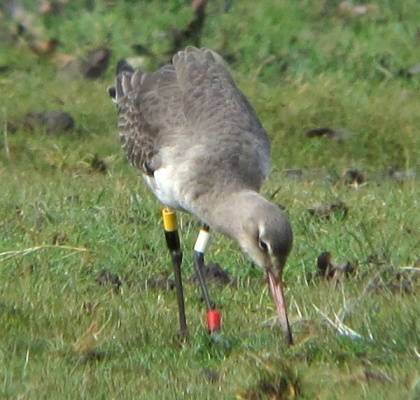
Other birds of note:
Off shore were 2 Sandwich Terns (still with remnants
of winter plumage, so probably over wintering birds
rather than migrants), 2+ Med Gulls, 197 Brent Geese,
18 Wigeon, 1 Great Crested Grebe and 7 Red Breasted
Mergansers displaying (see photo)

On the pond: 2 Teal
and a singing Chiffchaff at the rear.
Herons:
Nest 1 with three young (see photo):

Nests 8 and 11 at the
rear of the main Holm Oak (only viewable from the
horse paddock gate) were both in full swing with lots
of nest building and the adult on nest 8 was possibly
on eggs.
Nest 5: Birds mating several times and building nest
up with trips to the paddock for twigs and sticks
Nest 7: Adult also building up nest with plenty of
trips to the rear of the paddock for stick
collecting.
MONDAY
MARCH 4 - 2019
Slipper
Millpond
I had a stroll
down to Slipper Millpond this morning where I found
the regular pair of Great Black-backed Gulls
seemingly settled on the centre raft in
preparation for nesting on the pond for the 8th year
running. It will be interesting to see if the gulls
manage to remain on the centre raft for in the
previous two years they have been ousted by a pair of
Canada Geese which nested there, forcing the gulls to
nest on the smaller south raft.
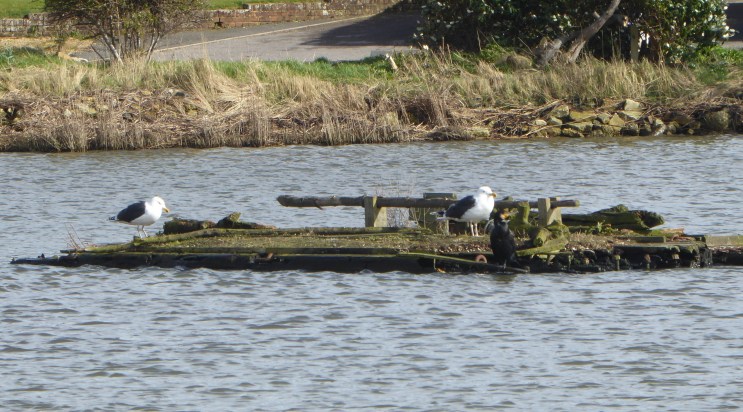
From previous
experience I would expect the gulls to be nest
building towards the end of this month and sitting in
early April. They usually lay 3 eggs and, if all goes
well, we should see chicks in early May. Last year,
three gull chicks were hatched of which two survived
and fledged successfully.
This morning the gulls were accompanied on the centre
raft by a Cormorant, which is unlikely to be tolerated
once nesting begins in earnest.
See the following
link for the history of these remarkable gulls . .
. Great
Black-backed Gulls on Slipper Millpond
While at the pond my attention was attracted by the
cries of a Mediterranean Gull which I
eventually tracked down among a flock of 200 or so
Black-headed Gulls. I could only see one of them
having a good splash.

Musk
Storksbill
Coming across
the main road from Slipper Millpond, I stopped to
check the Musk Storksbill on the grass verge on the
corner of Lumley Road with the large Hermitage road
sign.

This is the best place
locally to see this relatively uncommon casual plant.
The flowers are now showing well and are quite
different from the more common Common Stork's-bill. It
is an ancient introduction to the British Isles and
has an with a distinctly southern distribution, most
common in the South and East of England.
Cetti's
Warbler
Returning home
via the meadow I was pleased to hear the distinctive
song of a Cetti's Warbler from the bushes north of
Peter Pond. This was our first confirmed hearing of a
Cetti's Warbler this year on Brook Meadow, though Jo
Bray thought she may have heard one earlier in the
year (Jan 19) in Palmer's Road Copse. Cetti's Warbler
has been fairly regular spring visitor over the years
to Peter Pond and the Lumley Stream, though, saying
that, we had no hearings at all last year. Our best
year was 2010 when one was regularly heard and seen
from April through to June and even photographed.
Though very easy to hear, Cetti's Warbler is a
notoriously difficult bird to see let alone
photograph. Here is a nice shot taken by Tony Wootton
in April 2010.
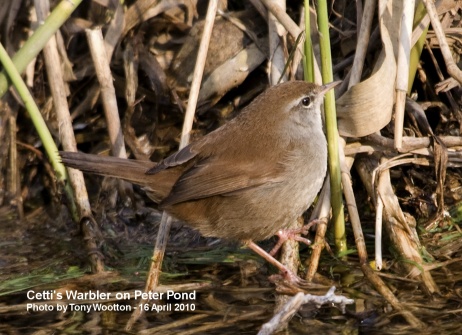
More
logs for volunteers
Returning home
via Brook Meadow, I came across three stalwart
volunteers (Dan, Reg and Terry) carrying logs and
branches though the Seagull Lane patch. They explained
that Norse had been cutting down overhanging branches
along the path at the end of Seagull Lane and they
were removing the debris for their wood burners.

In fact, Norse have
done a very good job in opening up the path which
should help it to dry out.
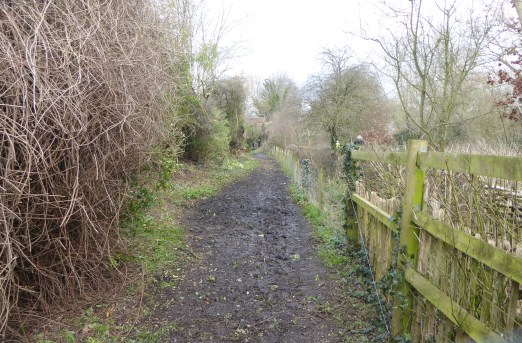
Norse also left a
large pile of wood chippings which the conservation
group can use for path maintenance.
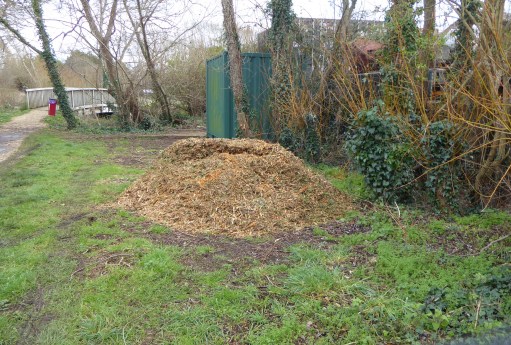
Warblington
Peter
Milinets-Raby was at Warblington today where he
reports . . .
"The ground was truly sodden after storm Freya had
passed through yesterday and this morning the fresh
inundation of rain had created lots of muddy puddles,
which in turn had attracted birds into the lush
verdant field west of the Warblington cemetery. 'All
white my son'. Everything was white!! Amongst the 5
Cattle Egrets were 24 Little Egrets and in
amongst the feeding flock of 130+ Black-headed Gulls
marching across the grass were 32 Mediterranean
Gulls - overall an impressive sight of whiteness!
Med Gulls were
generally everywhere this morning, their distinctive
calls were constantly filling the air as the odd birds
drifted over heading in land. Later I had a flotilla
of 55 of them resting on the high tide waters just off
Pook Lane. Only about 2 or 3 were out of full summer
plumage!
The rotting hay dump
was my main destination this morning as I had a short
wander around the Warblington fields and shore (9am to
11:08am - High tide throughout). There were up to 7,
possibly 9 pipits present - On each little fly around
I could not hear any Rock Pipits and certainly I did
not see any on the ground. I safely counted 4 Water
Pipits, 2 Meadow Pipits and 7 Pied Wagtails and 1
Grey Wagtail - some good views and photo opportunities
- the variance in plumage observed can only be due to
the birds starting their spring moult. White belly
always diagnostic.
Also flying around the
big field were a mobile flock of 42+ Linnets and 2
Skylarks.
Other birds of note this morning were: 1 Cetti's
Warbler singing from the hedge by the Ibis Field, plus
2 Redwing.
1 Chiffchaff feeding on the exposed muddy patch where
last years hay dump was located, along with 1 Water
Pipit and 2 Meadow Pipit (both birds probably on
excursion from the other hay dump - lots of commuting
back and forth between the two sites).
On the high tide water off Pook Lane were 64 Wigeon,
12 Teal, 4 Pintail, 7 Red Breasted Merganser and 1
Great Crested Grebe."
SUNDAY
MARCH 3 - 2019
Brook
Meadow
This morning's
weather forecast was dominated by strong winds and
rain from storm Freya hitting the UK from across the
Atlantic and the prospects seemed slim for the planned
conservation work session. However, the rain relented
and seven volunteers assembled at the tool store at
9.30am. The photo shows six, but one arrived later.
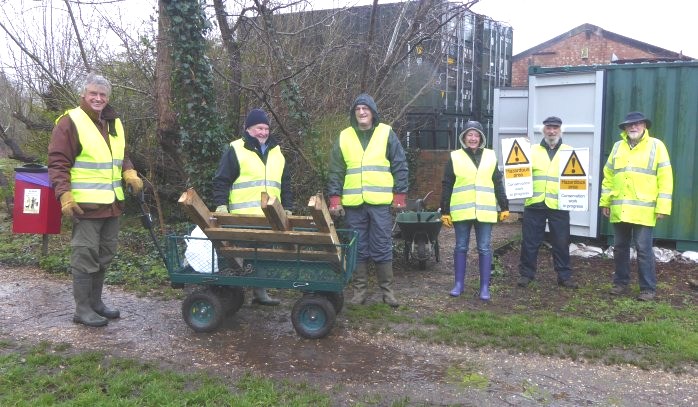
The main task of the
morning was to clear the logs and branches from the
river bank following the recent clearance of fallen
and overhanging trees by the Environment Agency.
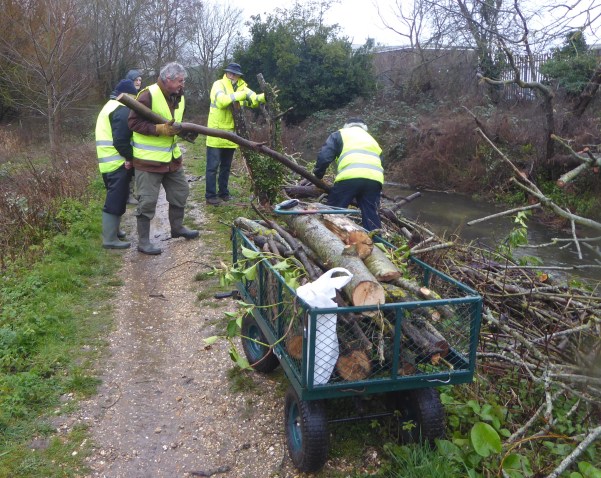
The larger logs were
moved to the gate at the end of Seagull Lane for
collection by members for their wood burners while
smaller branches and twigs were piled up for a bonfire
- but not today.

The white Cherry
Plum blossom on Brook Meadow is standing up well
to the strong winds, the tree on the causeway forming
an attractive archway along the path from the Lumley
gate.

Looked at from the
meadow the mass of white Cherry blossom contrasts
nicely with lines of straw-like leaves of Reed
Canary-grass and dark green leaves of Hard Rush in the
foreground.
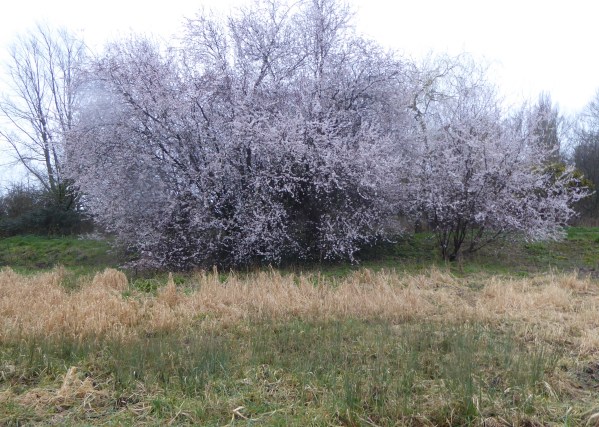
I checked the small
tree of white blossom in the north west corner near
the railway line which stands next to an Alder laden
with catkins; this is also Cherry Plum and not
Blackthorn.

Many flower spikes of
Butterbur are showing well and will soon be
countable!

SATURDAY
MARCH 2 - 2019
BROOK
MEADOW
Hedge laying
I popped over
to the meadow this morning to have a look at the
hedgerow on the west side of the Seagull Lane patch
which had been laid over the past two days by
volunteers under the guidance of Maurice Lillie and
Mike Probert. The newly laid section is at the far end
of the hedgerow and continues the good work done in
previous years. The laid hedge now looks quite
magnificent and should be even better when the bushes
start to leaf. An excellent piece of work. Well done
chaps. The photo was taken from the northern end
looking along the hedge towards the entrance gate. The
newly laid section of the hedge is closest.
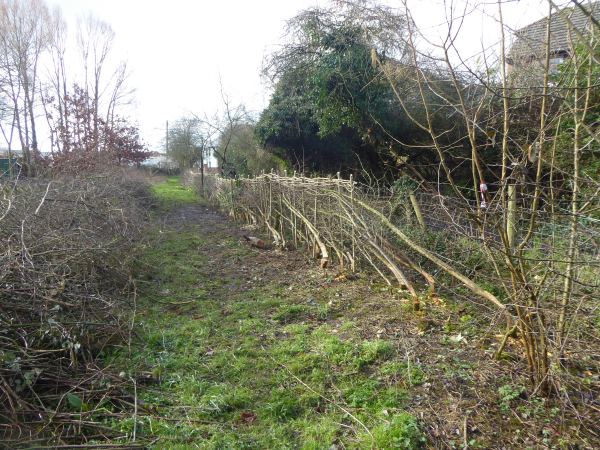
Here are a couple of
photos I got of Maurice, Mike and Terry at the start
of the work on Thursday. I hope Maurice will provide a
report and more photos in due course.
While I was on the
meadow I had a most unusual sighting - a Grey Heron
strolling along the raised footpath by the river.
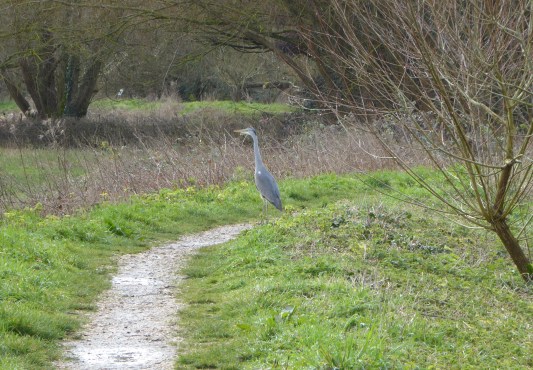
Signcases
I am grateful
to Dan Mortimer for his help with updating the
signcases. A couple of days ago Dan removed the three
display boards from the signcases and delivered them
to my home where I was able to assemble the photos and
texts for the spring update. This morning Dan
collected the boards from my home to take them back to
the meadow to reinstall in the signcases which he also
thoroughly cleaned. All went very smoothly and we
intend to follow this system for future updates.
Dan
cleaning the signcase near the north bridge.

FRIDAY
MARCH 1 - 2019
Stansted
Forest
After enjoying
a latte coffee and a warm fruit scone in the Pavilion
Tea Rooms at Stansted, Jean and I walked through the
east park passing the Iron Gate Cottages on the way.

This is where we saw
three Ravens soaring overhead, alerting us by
their distinctive croaking calls. I gather at least
two pairs of Ravens nest on the Stansted Estate. Here
is a distant shot I got of one of them.

Less exciting was a
pair of Long-tailed Tits flitting back and
forth from the overhead cables along the eastern
track.

Walking back towards
Stansted house we heard a distant drumming of a
Great Spotted Woodpecker, the sound carrying
strongly across the fields from the Ladies Walk area.
This is the courtship call of the male bird and
signals the start of the breeding season.
Another first that I was listening out for during the
walk was the song of a Mistle Thrush wafting
over the fields coming from one of the copses on the
main Avenue.
It was good to see
masses of Primroses in the garden area near the house.
Here is one we spotted surrounded by green mosses at
the base of a mature Sweet Chestnut tree.

We kept a lookout for
Blackthorn blossom - several examples of which
we discovered in the hedges with lots more to come.
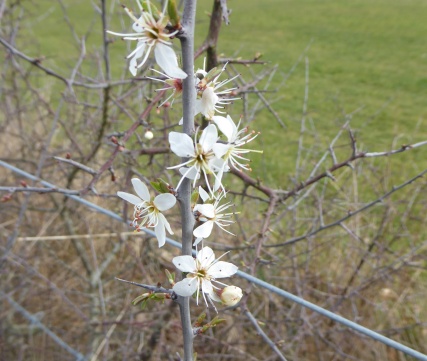
For
the previous entries go to . . February
1-28